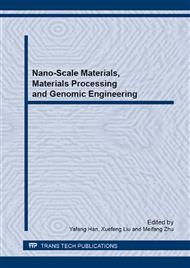[1]
I. Choi, J.G. Kim, I.S. Seo, D.G. Lee, Radar absorbing sandwich construction composed of CNT, PMI foam and carbon/epoxy composite, Compo. Struct. 94 (2012) 3002-3008.
DOI: 10.1016/j.compstruct.2012.04.009
Google Scholar
[2]
I. Huynen, N. Quiévy, C. Bailly, P. Bollen, C. Detrembleur, S. Eggermont, I. Molenberg, J.M. Thomassin, L. Urbanczyk, T. Pardoen, Multifunctional hybrids for electromagnetic absorption, Acta. Mater. 59 (2011) 3255-3266.
DOI: 10.1016/j.actamat.2011.01.065
Google Scholar
[3]
G. Li, T. Xie, S. Yang, J. Jin, J. Jiang, Microwave Absorption Enhancement of Porous Carbon Fibers Compared with Carbon Nanofibers, J. Phys. Chem. C. 116 (2012) 9196-9201.
DOI: 10.1021/jp300050u
Google Scholar
[4]
V. K. Singh, A. Shukla, M. K. Patra, L. Saini, R.K. Jani, S.R. Vadera, N. Kumar, Microwave absorbing properties of a thermally reduced graphene oxide/nitrile butadiene rubber composite, Carbon. 50 (2012) 2202-2208.
DOI: 10.1016/j.carbon.2012.01.033
Google Scholar
[5]
M. S. Cao, W.L. Song, Z.L. Hou, B. Wen, J. Yuan, The effects of temperature and frequency on the dielectric properties, electromagnetic interference shielding and microwave-absorption of short carbon fiber/silica composites, Carbon. 48 (2010) 788-796.
DOI: 10.1016/j.carbon.2009.10.028
Google Scholar
[6]
P. C. Kim, D. G. Lee, W.G. Lim, I.S. Seo, Polarization characteristics of a composite stealth radome with a frequency selective surface composed of dipole elements, Compo. Struct. 90 (2009) 242-246.
DOI: 10.1016/j.compstruct.2009.03.002
Google Scholar
[7]
Y.X. Kong, T.T. Qiu, J. Qiu, Fabrication of novel micro–nano carbonous composites based on self-made hollow activated carbon fibers, Appl. Surf. Sci. 265 (2013) 352-357.
DOI: 10.1016/j.apsusc.2012.11.011
Google Scholar
[8]
A. Abbaspour-Tamijani, K. Sarabandi and G.M. Rebeiz: 'Antenna-filter-antenna arrays as a class of bandpass frequency-selective surfaces', IEEE T. Microw. Theory, 2004, 52, 1781 - 1789.
DOI: 10.1109/tmtt.2004.831572
Google Scholar
[9]
X. Wei, C. Hai-Feng, C. Zeng-Yong, Z. Yong-Jiang, L. Hai-Tao, C. Zhao-Hui, Effect of FSS on microwave absorbing properties of hollow-porous carbon fiber composites, Mater. Design, 30 (2009) 1201-1204.
DOI: 10.1016/j.matdes.2008.06.018
Google Scholar
[10]
P.C. Kim, W.S. Chin, D.G. Lee, I.S. Seo, EM characteristics of the RAS composed of E-glass/epoxy composite and single dipole FSS element, Compo. Struct. 75 (2006) 601-609.
DOI: 10.1016/j.compstruct.2006.04.085
Google Scholar
[11]
W.J. Lee, J.W. Lee, C.G. Kim, Characteristics of an electromagnetic wave absorbing composite structure with a conducting polymer electromagnetic bandgap (EBG) in the X-band, Compo. Sci. Technol. 68 (2008) 2485-2489.
DOI: 10.1016/j.compscitech.2008.05.006
Google Scholar
[12]
S.E. Lee, K.Y. Park, K.S. Oh, C.-G. Kim, The use of carbon/dielectric fiber woven fabrics as filters for electromagnetic radiation, Carbon. 47 (2009) 1896-1904.
DOI: 10.1016/j.carbon.2009.02.013
Google Scholar
[13]
H.T. Liu, H.F. Cheng, Z.Y. Chu, D.Y. Zhang, Absorbing properties of frequency selective surface absorbers with cross-shaped resistive patches, Mater. Design. 28 (2007) 2166-2171.
DOI: 10.1016/j.matdes.2006.06.011
Google Scholar
[14]
D.H. Ding, W.C. Zhou, F. Luo, D.M. Zhu, Influence of pyrolytic carbon coatings on complex permittivity and microwave absorbing properties of Al2O3 fiber woven fabrics, T. Nonferr. Metal. Soc. 22 (2012) 354-359.
DOI: 10.1016/s1003-6326(11)61183-7
Google Scholar
[15]
H.L. Fan, W. Yang, Z.M. Chao, Microwave absorbing composite lattice grids, Compos. Sci. Technol. 67 (2007) 3472-3479.
DOI: 10.1016/j.compscitech.2007.03.002
Google Scholar
[16]
Y. Sha, K.A. Jose, C.P. Neo, V.K. Varadan, Experimental investigations of microwave absorber with FSS embedded in carbon fiber composite, Microw. Opt. Techn. Let., 32 (2002) 245-249.
DOI: 10.1002/mop.10144
Google Scholar
[17]
N. Zhao, T. Zou, C. Shi, J. Li, W. Guo, Microwave absorbing properties of activated carbon-fiber felt screens (vertical-arranged carbon fibers)/epoxy resin composites, Mater. Sci. Eng. B-Adv. 127 (2006) 207-211.
DOI: 10.1016/j.mseb.2005.10.026
Google Scholar


